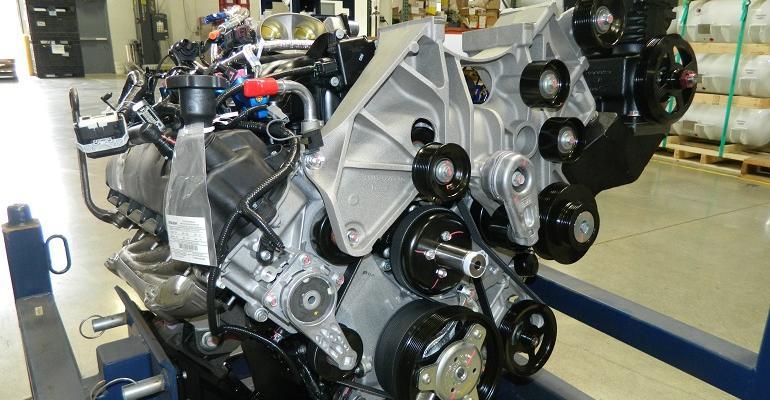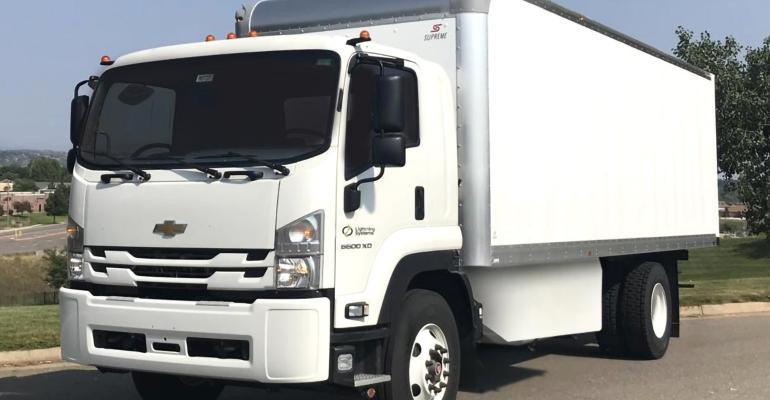
kscarbel2
Moderator-
Posts
18,868 -
Joined
-
Days Won
114
Content Type
Profiles
Forums
Gallery
Events
Blogs
BMT Wiki
Collections
Store
Everything posted by kscarbel2
-
-
Behind the Wheel of an Electric Peterbilt Model 579
kscarbel2 replied to kscarbel2's topic in Trucking News
-
-
Ford downgraded by Moody's to one level above junk status Michael Martinez, Automotive News / August 29, 2018 DETROIT -- Roughly six years after Ford Motor Co. returned to investment grade and reclaimed its mortgaged Blue Oval, the automaker is once again in danger of plunging into junk bond status. Moody's Investors Service on Wednesday downgraded Ford to Baa3 from Baa2, a move the credit agency telegraphed earlier this year when it changed its rating outlook on Ford to "negative" from "stable." The agency cited "erosion in the company's global business position and the challenges it will face implementing its Fitness Redesign program." Ford last month said it would undergo an $11 billion global restructuring effort over the next three to five years. "The Fitness program is a necessity, but it will take several years for material financial and operating benefits of the program to be realized," Moody's said. "Success could be challenged by having to address the serious performance problems in multiple business units simultaneously. At the same time, Ford will have to continue investing in the areas critical for the future of the auto industry. These areas include alternative propulsion, autonomous driving, ride sharing and connectivity." Ford shares fell 0.4 percent to close Wednesday at $9.97 in New York. Ford, in a statement, said it's delivered "year after year of solid financial results" since the Great Recession. "The company has a strong balance sheet, which provides financial flexibility," spokesman Brad Carroll said. "We know we can capitalize on our strengths, bolster underperforming products and regions and disposition where we cannot make an appropriate return. We’re confident that as we do, the market will recognize our progress.” Moody's said the prospect of an upgrade to Ford's rating through 2020 is "very modest," and that it could fall to junk status "absent clear progress in pursuing the Fitness initiatives by early to mid-2019, with evidence that the company is on a strong trajectory for recovery." Ford is in the midst of reorganizing its business in North America by slashing $25.5 billion worth of engineering and other costs. That includes a product overhaul that involves cutting virtually all of its sedans, redesigning most of its utilities and adding products in new segments like off-road utilities and midsize pickups. Earlier this week, Ford announced the creation of a new management organization tasked with studying customers to develop more profitable and competitive vehicles.
-
Ford CEO Jim Hackett talks X's and O's of leadership with Michigan's Jim Harbaugh Nick Bunkley, Automotive News / August 29, 2018 Imagine GM CEO Mary Barra plays on Ohio State's offensive line. That's basically how Jim Hackett pictures her. The Ford Motor Co. CEO says he got the idea from his football coach at the University of Michigan, the late Bo Schembechler. Hackett, a backup center on Schembechler's powerhouse teams in the mid-1970s, was a guest on this week's episode of "Attack Each Day," a weekly podcast hosted by Michigan's current coach, Jim Harbaugh, and his father, Jack. Hackett explained one of Schembechler's motivational strategies: "He would have your position and your name, 'Jim Hackett,' and he'd have the center from Ohio State, and he'd say, 'Are you going to outplay him today?' So I do this thing where I go, 'Is Jim Hackett going to outplay Mary Barra today?' " He continued: "Is Clare Braun, my chief of staff who's here today, is she better than the people at Chrysler? He made you see that competing was what you had to get yourself ready to do." Since replacing Mark Fields as CEO in May 2017, Hackett has talked repeatedly of the need to improve Ford's "fitness," so it can "compete and win." It's clear that his football days were a major influence in how he has approached the business world, in 20 years running the Steelcase furniture company and now in his time at Ford. In between, Hackett did a brief stint as Michigan's interim athletic director and hired Jim Harbaugh to resurrect the Wolverines' troubled football program. Hackett was hailed as a hero in Ann Arbor for nabbing Harbaugh and reversing other unpopular moves by his predecessor, but things haven't quite played out on the field as many fans had hoped. Harbaugh logged a 28-11 record in his first three seasons and has yet to beat Michigan's chief rival, Ohio State. Meanwhile, just a short distance away, it's tough to argue that Hackett is outplaying Barra, at least on the scoreboard that Wall Street and other outsiders can see. Ford's stock price is down, analysts have been agitated by vague messaging, and Hackett has launched a turnaround effort that's more extensive and costly than many experts had anticipated. Hackett said Harbaugh's critics are misguided and short-sighted. "If I hear that," Hackett said, "I ask them if they know football." Hackett's comments left the impression that he, similarly, hasn't been rattled by the mounting questions about his leadership of Ford and intends to keep barreling forward, demanding patience from stockholders and employees. Hackett said he often listens to sports talk radio while commuting from Ann Arbor to Dearborn and grows agitated by callers criticizing Harbaugh, who opens his fourth season this weekend as a one-point underdog against Notre Dame. "One of the things I worry about is I'm going to call in one day," Hackett said near the end of his hourlong appearance on the Harbaughs' podcast. (The episode, released Tuesday, was titled "Think Ford First" and also revealed that Hackett gave Harbaugh a Mustang convertible this summer.) "I can't take some of the mythical -- they don't understand how good we are, how great we have it, so I hold back," Hackett said. "They won't give him enough credit for what he's done since he's here." .
-
Call Watt's Mack at 1-888-304-6225 and ask for a 32MK53 (black painted) or 32MK53P4 (chrome).
-
Trailer-Body Builders / August 28, 2018 ROUSH CleanTech, an alternative-fuel technology company, recently developed the first available propane autogas engine certified to California Air Resources Board’s optional low oxides of nitrogen emissions standard for heavy-duty engines with 0.02 grams per brake horsepower-hour (g/bhp-hr). The engine is 90-percent cleaner than the current Environmental Protection Agency’s most stringent 0.2 g/bhp-hr heavy-duty engine standard, ROUSH said. “Last year, we introduced a propane autogas engine that was 75-percent cleaner than the EPA’s emissions standard,” said Todd Mouw, president of ROUSH CleanTech. “But, we knew our next challenge was to meet CARB’s lowest NOx standard at 0.02 g/bhp-hr. “Our newest propane autogas engine reinforces ROUSH CleanTech’s commitment to provide vehicle solutions that reduce the impact to the environment while leveraging an abundant, domestically produced fuel that costs less than diesel.” NOx emissions are regulated under federal air quality standards because they are harmful to human health and the environment, contributing to regional ozone attainment challenges, smog and other air-quality issues. Heavy-duty diesel trucks are the single largest source of NOx emissions, contributing to smog in a majority of the nation’s most populated urban regions. According to the EPA, operating vehicles with ultra-low emission engines can make significant improvements to regional air quality and reduce a wide variety of human health impacts. “In Southern California, the development and deployment of near-zero emission vehicle technologies are critical to meeting clean air standards,” said Wayne Nastri, executive officer for the South Coast Air Quality Management District. “We congratulate ROUSH CleanTech on this achievement.” This new certification covers all of ROUSH CleanTech’s 6.8L V10 3V propane engines for Class 4-7 vehicles. Installation of the new optional ultra-low NOx engines has begun with some 2018 Ford commercial vehicles and Blue Bird Vision propane school buses. ROUSH CleanTech, which has deployed more than 18,000 propane autogas vehicles, will manufacture both the low-NOx 0.05 and ultra-low NOx 0.02 g/bhp-hr propane engines. School, shuttle and transit buses and Class 4-7 medium-duty trucks equipped with ultra-low NOx engines are expected to be very competitive in seeking funding from the Volkswagen Environmental Mitigation Trust settlement, the company said. “The certification of this ultra-clean propane engine could not have come at a more opportune time as private and public fleets can now begin applying for a piece of the $2.9 billion Volkswagen settlement funds,” said Tucker Perkins, president of the Propane Education & Research Council. “The settlement is meant to fund projects that cost-effectively reduce NOx emissions, so vehicles powered by the new ultra-low NOx ROUSH propane autogas engine are an ideal fit for accomplishing this goal.” .
-
Ford forms new group to develop more profitable, competitive vehicles Michael Martinez, Automotive News / August 28, 2018 Ford Motor Co. wants to apply its deep understanding of truck customers across its lineup. The automaker this week formed what it calls an Enterprise Product Line Management group to work with marketing, engineering, mobility and product development teams to overhaul the company's vehicle portfolio. The goal is to better study what customers want and build more profitable, competitive vehicles. It's an approach Ford has taken with its most popular vehicle: the F-series pickup. The automaker also credits its leadership in commercial vehicles and sports cars to the same obsession with understanding its buyers' specific needs. "By taking this approach, we can raise the bar across our product lines," Jim Farley, Ford's president of global markets, said in a statement. "Each team will have clear accountability for winning in the marketplace and delivering profitable growth." Ford's profit margin on its global operations in the second quarter was 2.7 percent, down from 5.1 percent a year earlier. Its North American margin declined to 7.4 percent from 9.5 percent in the second quarter of 2017. Executives have targeted 8 percent global margins -- 10 percent in North America -- by 2020. Ford tapped Jim Baumbick as vice president of the new group. Baumbick, who becomes a company officer and reports to Farley, had been executive director of global product planning and strategy. The formation of the new group comes as Ford prepares a product overhaul. In the coming years, it's cutting virtually all of its traditional car offerings, redesigning many of its crossovers and SUVs and entering new segments such as off-road utilities and midsize trucks. By 2020, Ford plans to have the freshest showroom in the industry with an average vehicle age of 3.3 years. By 2023, the Ford brand's number of nameplates will rise to 23 from 20 today. Ford CEO Jim Hackett and other senior executives say the automaker wants to offer products in segments where it knows it can win, and it hopes the new organization can help it get there. It's organizing its products into 10 categories: F series, urban utilities, rugged utilities, family utilities, performance vehicles, commercial vehicles, electric vehicles, compact trucks, luxury vehicles and emerging-market vehicles. .
-
Limited edition Diamond T glider kit offering unveiled
kscarbel2 replied to kscarbel2's topic in Trucking News
Exactly, if it's affordably priced. I'm still wondering how T-Line can make money........reaching there of course depends on achieving economy-of-scale. Out of the blue, I can imagine this as a great municipality truck. The basic get-it-done truck like the Louisville was. -
Limited edition Diamond T glider kit offering unveiled
kscarbel2 replied to kscarbel2's topic in Trucking News
C'mon Mark, I hear you, but these guys have a very modest budget. I think what they've done here, with limited funding, is a viable vehicle. -
Ford aims to spread Mustang's DNA Michael Martinez, Automotive News / August 27, 2018 DETROIT — After 10 million vehicles over 54 years, the Mustang remains one of the most vital nameplates in Ford Motor Co.'s stable. It's Exhibit A for what the Ford brand wants to stand for: bold, emotional designs that elicit passion among its customers. The rest of its cars lack that cachet, which is why, after the Fusion sedan disappears from showrooms early next decade, the Mustang effectively will be Ford's last car standing as the brand shifts to a lineup dominated by pickups and utility vehicles. Now, Ford is trying to re-create that Mustang magic in its crossover and SUV lineup. One vehicle in particular, a yet-to-be-named battery-electric crossover, was heavily inspired by the Mustang; Ford floated the name Mach 1 for it this year, though the production version is likely to get a different moniker. "It's core to what people see Ford as," Carl Widmann, the Mustang's chief engineer, told Automotive News. "We wanted a vehicle that would draw people to the showroom floor. There's clear evidence that's the case." The Mustang has been the best-selling sports coupe in the U.S. since its redesign in 2014. Ford began selling the Mustang globally in 2015 and now sells it in more than 140 markets, including China, Germany and Australia. Despite the Mustang's importance to the company, CEO Jim Hackett reportedly pushed back the seventh-generation program by about a year. A redesigned Mustang now is expected in 2021. The car rides on an exclusive rear-wheel-drive platform but could move to one of the company's five new modular architectures, presumably the rwd/all-wheel-drive unibody underpinnings it would share with utilities such as the Explorer and Lincoln Aviator. That would give Ford the option of building an awd pony car for better handling in winter and to compete with the awd version of the Dodge Challenger that launched in 2017. The company also plans the first Mustang hybrid, set to arrive in 2020. Members of the Mustang team were mum on details about the next-generation car but said the move to a modular architecture won't hurt their design creativity. "Mustang is still going to be a strong, well proportioned vehicle," the Mustang's chief designer, Darrell Behmer, said. "The modular architectures will still give us flexibility; it's not going to bastardize Mustang." 'A tremendous trick' Widmann said the move won't fundamentally change the car. "The general layout of rwd has morphed over time, but it's still the general architecture that it has been," he said. "In the architecture world of a rwd — which you're going to end up with a rwd architecture — I think these pieces of it are pieces that will always work. As you tune it and put a top hat on it, you can get different combinations and can define a lot of the emotion." The current-generation Mustang resonates so well, Widmann said, because of its styling, diverse powertrains and driveability on or off a racetrack. The team worked to give the 2015 model a more aggressive look while keeping traditional design elements. The vehicle's footprint was unchanged, but the roof and hood were lowered about 1.2 inches. Visibility also was key, Widmann said, as the team tried to maintain the previous generation's proportions. "It's critical to always have the ability to keep theme elements but not be stuck in a rut," Widmann said. "It's a balance of not being caught in the past but still moving forward, which is a tremendous trick." Ford has made incremental improvements since the 2015 redesign, adding a 10-speed automatic transmission and dropping the V-6 engine in 2018. It also has reintroduced special editions, including the Bullitt and California Special, and revived performance variants such as the Shelby GT350 and Cobra Jet. Although U.S. sales are down 4.8 percent this year to 48,362 through July, the car is outselling its chief rivals: the Challenger and Chevrolet Camaro. "It's the heart and soul of Ford," Jim Farley, Ford's president of global markets, said at a celebration this month of the 10 millionth Mustang produced. "It's one of the reasons why we're different and it continues to inspire other vehicles in the lineup." Performance and utility The Mustang-inspired electric crossover, due in 2020, likely will borrow heavily from the pony car's front-end design and combine the performance of an EV with the utility of an Explorer-like crossover. Just don't expect it to be called Mach 1, a name Ford used for a Mustang performance option at various times from 1968 through the 2004 model year. "We put that out there to evaluate it," Farley said of the name. "There are pros and cons. I don't want to handicap it at this point, but we got a very strong reaction from people." After Ford released a teaser video for the vehicle this year, one YouTube user responded: "If they end up calling an SUV a Mach 1, I will never buy a Ford car or truck as long as I live. Blasphemy!" Another added: "As a man who owns a 2003 mach 1 5-Speed, I am DISGUSTED. The mach 1 is the most iconic stang and you're disgracing its name with this. Shame." Regardless of what name Ford picks, people who have helped shape the Mustang are excited by the prospect of expanding its DNA to other vehicles. "Mustang has a soul. It's a balance of performance and design," Behmer said. "If you can capitalize on the cachet and let that rub off on the rest of the portfolio, it's a good thing."
-
Is that true? They want that big of a change in specs, from an Explorer chassis to a full-size van for residential delivery??? The full-size high-roof (single or dual rear tire) Transit could easily be modified for the mission. I've never seen a Transit rust.
-
Matt Cole, Commercial Carrier Journal (CCJ) / August 27, 2018 More than 1,200 model year 2012-2015 Freightliner and Western Star tractors are being recalled over an issue that could cause a tie rod failure, according to documents from the National Highway Traffic Safety Administration. Daimler Trucks North America alerted NHTSA of potentially 1,256 trucks that could be affected, however DTNA estimates that only 1 percent of recalled trucks are affected. Trucks included in the recall are: 2012-2015 Freightliner 114SD 2012-2015 Freightliner Business Class M2 2012-2015 Freightliner Cascadia 2012-2015 Freightliner Coronado 2012-2015 Western Star 4900 According to NHTSA documents, in certain front axle, brake lining and brake spider combinations, braking can cause high vibrations, resulting in the failure of the tie rod tube. A tie rod failure would cause a disconnect between the front wheels, resulting in a loss of steering. DTNA will begin notifying affected truck owners on Sept. 24, and dealers will replace brake linings, brake spiders and tie rods for free. Owners can contact Daimler customer service at 1-800-547-0712 with recall number FL782. NHTSA’s recall number is 18V-503.
-
Fleet Owner / August 27, 2018 Zero-emission commercial powertrains developer Lightning Systems announced a new electric powertrain for Chevrolet's Low-Cab Forward trucks with 19,501-26,000 pound gross vehicle weight rating that offers an all-electric range of 110 miles. Zeem Solutions has placed the first order of 50 of the powertrains, which will be integrated into Chevy 6500XD Low Cab Forward trucks. Zeem Solutions is a commercial electric vehicle service provider for small to large fleets and helps fleet operators integrate an electric vehicle strategy to meet fleet transportation requirements. The company's CEO, Paul Gioupis, had strong testimony to the electric Class 6 Chevy 6500XD's performance: "The truck is an absolute beast, and there is no other product on the market like it." "We chose the Lightning product because once we drove the electrified Ford Transit [with Lightning Systems' conversion], we were blown away with the acceleration and overall performance, and it became clear why Ford selected them as their preferred partner," Gioupis added. The new Lightning Electric LEV100 model will offer peak motor power of 295 hp. with a 2-speed Eaton automatic transmission, providing 1821 lbs.-ft. of torque in first gear and a 65-mph governed top speed. The electric 6500XD will have a range of 110 miles, depending on route and driver. Regenerative braking adds range while reducing wear and tear on the standard friction brakes. The Lightning Electric powertrain will accommodate a full charge in three hours with DC fast-charging. Lightning Systems provides a five-year, 60,000-mile warranty on the powertrain, similar to General Motors' vehicle warranty. The powertrain is available on new Class 6 Low-Cab Forward trucks as well to repower existing fleet vehicles. Service and maintenance will be performed by trained local service centers and nationwide service partners, Lightning Systems noted. The electric Low-Cab Forward model will serve as a cargo van for delivery and comes as a chassis cab ready to be upfitted with cargo box, refrigeration units, and other configurations. Tim Reeser, CEO of Lightning Systems, noted the electrified 6500XD follows the company's pattern of converting a truck "that is already embedded in fleets, trusted by commercial customers, and is highly serviceable with nationwide spare parts." "Just like our Ford Transit and city bus powertrains, the vehicle is elegantly engineered, quick, powerful, and quiet," he added. Orders are being accepted immediately, Lightning Systems said, and delivery of the new product is expected to begin in the fourth quarter of 2018. The company did not specify whether the conversion will also be available for Isuzu's Class 6 FTR truck, which is the cross-platform sibling to the Isuzu-built Chevy 6500XD, or for other Class 6 cabovers. .
-
So Workhorse went under $1.00 today, reaching a 52-week low of 0.91. I hate to say it, but I don't think they're going to make it. Even if their partners win the USPS contract, that might only prolong the inevitable. And the partners might not want to work with a financially insolvent Workhorse. I didn't agree with all of Ustian's tie-ups, but I did feel the Navistar-Workhorse package had a lot of synergies.
-
China has become the most profitable car market in the world for most automakers. Many couldn't survive without it. I can tell you that BMW, Daimler and Volkswagen earn over half their profits there nowadays, which is to say, they've become addicted to the Chinese market and couldn't survive without it. Remember, China overtook the US in 2009 to become the world's largest new car market.
-
Limited edition Diamond T glider kit offering unveiled
kscarbel2 replied to kscarbel2's topic in Trucking News
Ted, that's a rebadged SinoTruk (aka. CNHTC) "A7". https://product.360che.com/s0/46_66_pic.html https://www.bigmacktrucks.com/topic/53333-daysworth-ressurrects-diamond-reo-brand/?tab=comments#comment-398622 -
Limited edition Diamond T glider kit offering unveiled
kscarbel2 replied to kscarbel2's topic in Trucking News
And that's exactly what I like about it. -
Limited edition Diamond T glider kit offering unveiled
kscarbel2 replied to kscarbel2's topic in Trucking News
Myself, I don't see any similarity between the new Diamond T and the old International S-Series (except in those pictures they're both white). But to each his own. Given T-Line's small budget, I'm thrilled at their accomplishment and wish them the best. -
Without stating a price, it would seem that you're not actually serious about selling this truck.
-
Yes sir. The face of US government tells the masses all about how the US came out ahead, as Clinton did with NAFTA 1.0, and most shrug and believe it. All US market cars, aside from low volume niche models, should be produced in the US. I say that, because as the world's no.2 new car market by size, we can demand it. But the world's auto and truckmakers don't want that, and big business runs the world (e.g. how NAFTA came to be).
BigMackTrucks.com
BigMackTrucks.com is a support forum for antique, classic and modern Mack Trucks! The forum is owned and maintained by Watt's Truck Center, Inc. an independent, full service Mack dealer. The forums are not affiliated with Mack Trucks, Inc.
Our Vendors and Advertisers
Thank you for your support!









